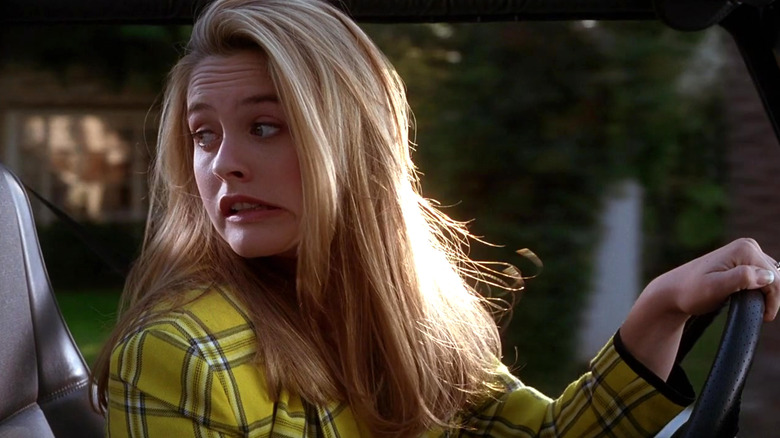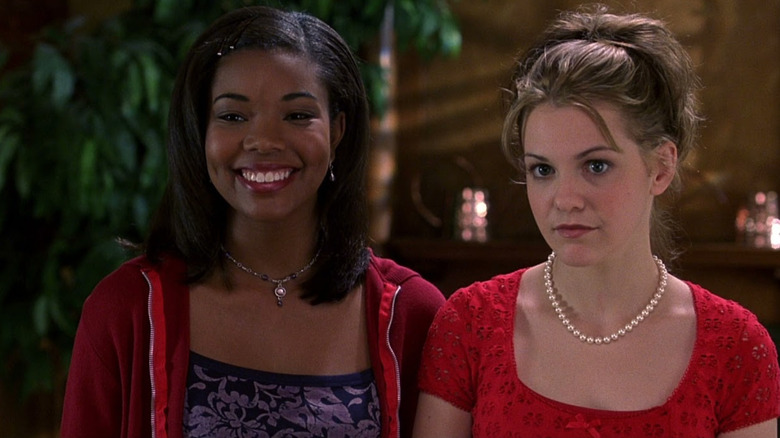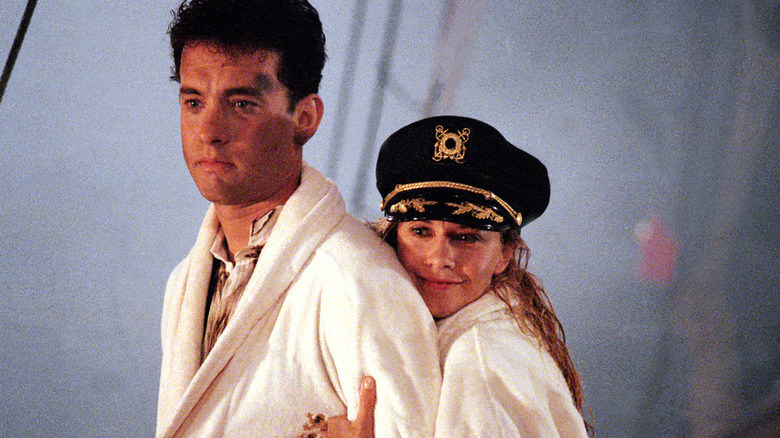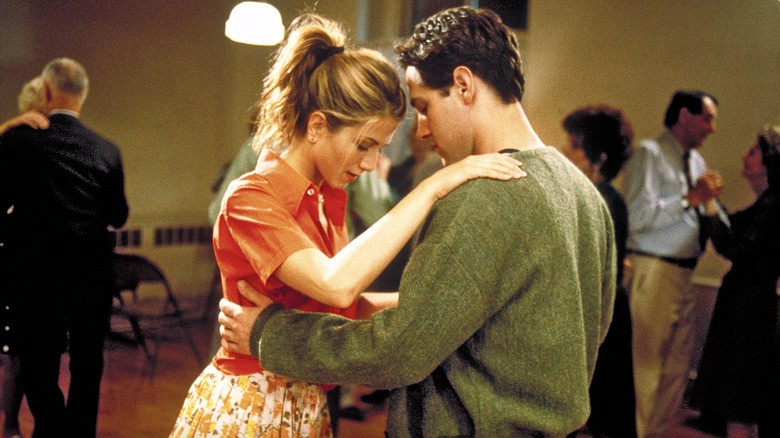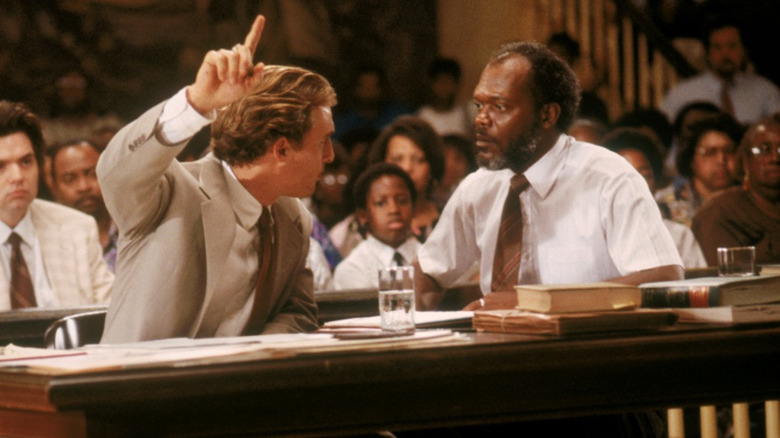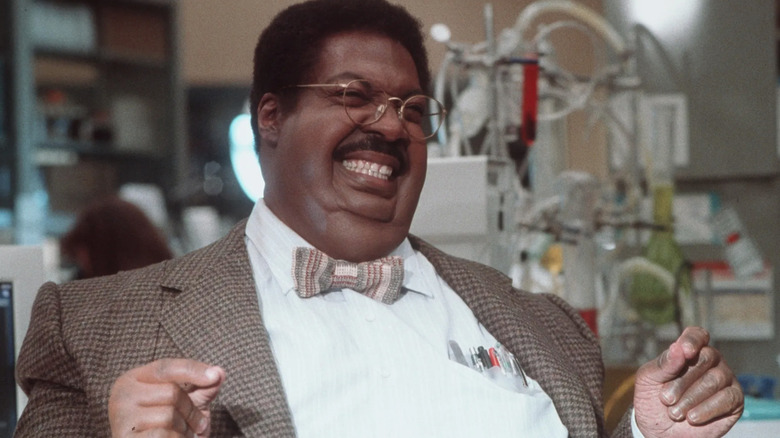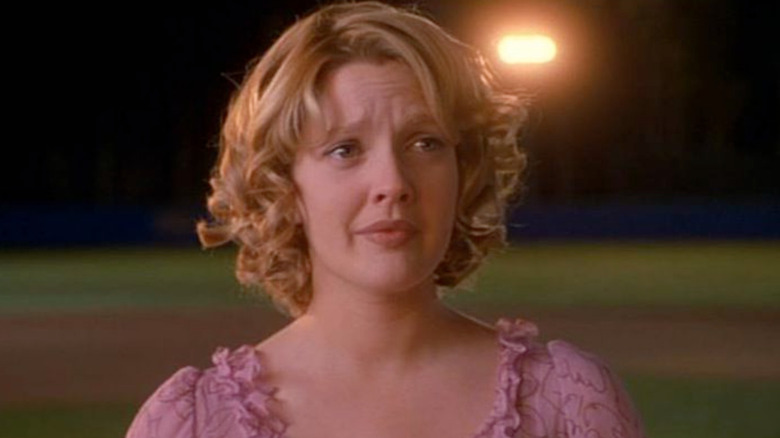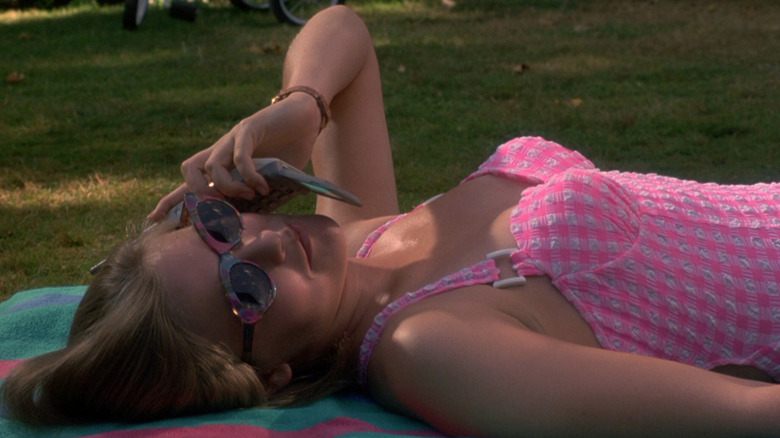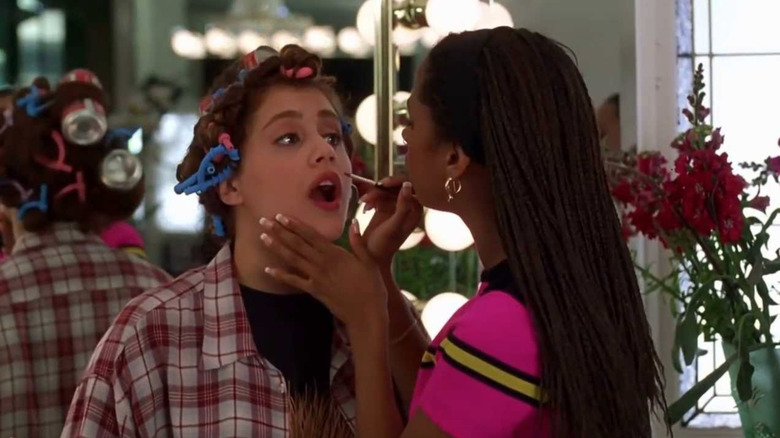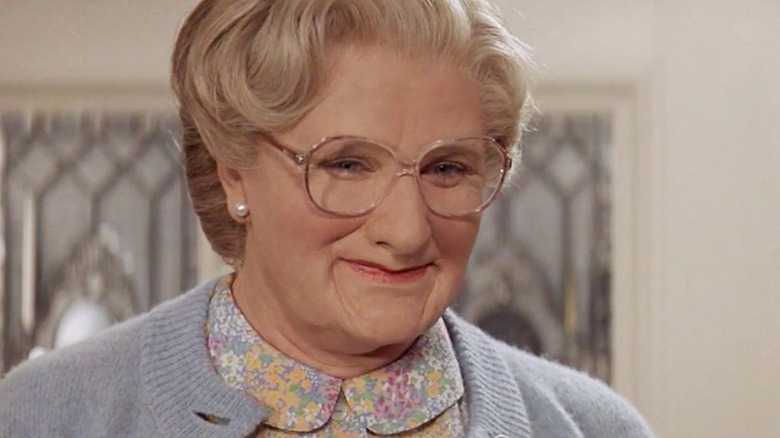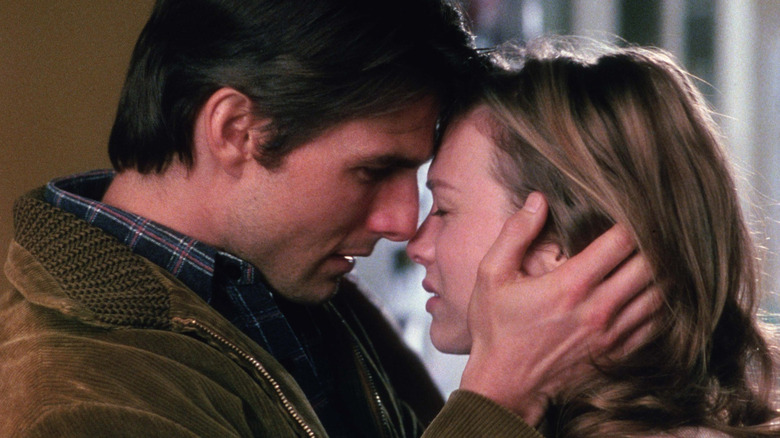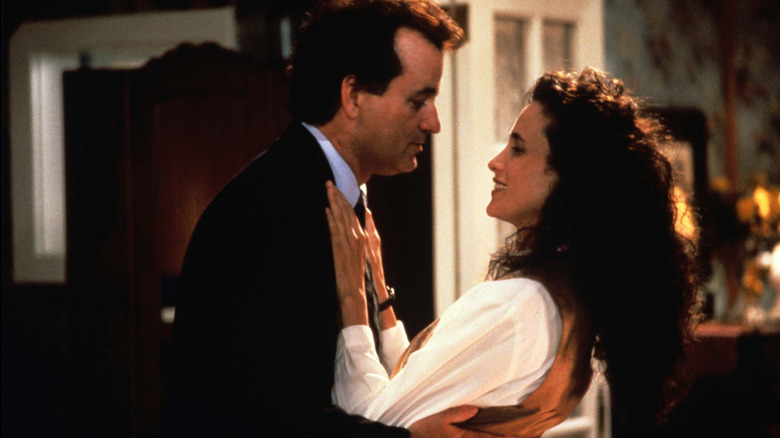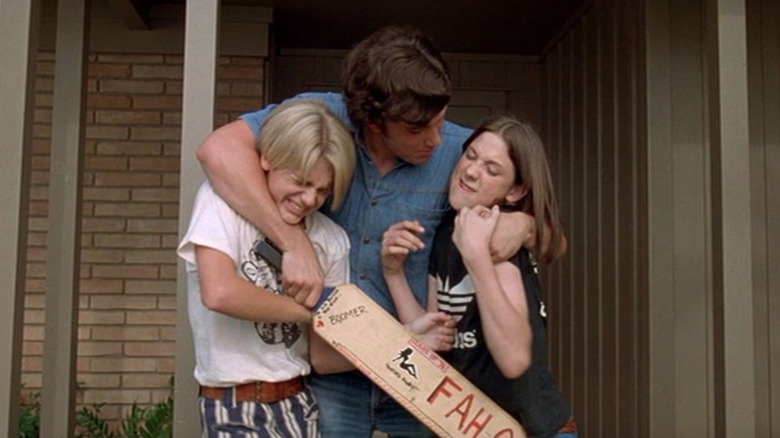Tropes From '90s Movies We're Glad Hollywood Has (Mostly) Left Behind
When thinking about your favorite movies from the '90s, nostalgia makes it easy to look back through the lens of rose-colored glasses. For many, the decade stands out as one of the most transformative eras in cinematic history. It was an era where a hodgepodge of popular genres shared the screen harmoniously. There was something for everyone, ranging from offbeat comedies to large-scale blockbusters to independent gems — all of which have generated classics that have stood the test of time.
On the other hand, it's only fair to acknowledge the abundance of dumpster fire flops that also coincided. And while we'd all prefer to write off "Baby Geniuses" as a fever dream, movies like this defined the decade just as much as movies like "Clueless" or "Pulp Fiction." Of course, even the beloved '90s classics have their flaws — often relying on cliche storylines and prioritizing cisgender, white perspectives under the guise of superficial diversity.
As the film industry continues to evolve and learn from past mistakes, certain problematic and outdated tropes that once populated the majority of '90s movies have been reevaluated. Although many of these tropes still exist today in some form, they've become a lot less popular. So for the sake of pushing creative boundaries and meaningful inclusivity, let's reflect on the tropes from '90s movies we're glad Hollywood has (mostly) left behind.
Token minority character
Tokenism has been a lingering problem in the film industry, where writers and producers include minority characters in a majority cis-white cast for the sole purpose of conveying haphazard representation. The token minority character is often given a supporting role as the sidekick or best friend to the cis-white main character. Their presence is used as a get-out-of-jail-free card to avoid criticism without having to offer authentic visibility or nuanced discussions. "Again and again, this same construct was thrown at me by pop culture: token ethnic friends in movies and shows that I loved, reminding me that real life only happened to white people. As a brown girl I was support, not the leading role," Zoya Patel explained in The Guardian.
The '90s heavily relied on this symbolic trope to attract wider audiences and simulate diversity during a time of social progression. In "She's All That," the characters Katie and Alex make up Taylor's mean girl entourage. But don't expect them to say or do much: They're portrayed as one-dimensional set pieces that reinforce and advance the white main character's development. The same can also be said for Bianca's friend Chastity in "10 Things I Hate About You," or even Dionne in "Clueless." More recently, there's been an effort to combat the harmful trope of tokenism in movies, with audiences and industry workers holding Hollywood accountable and promoting genuine inclusion by elevating diverse perspectives and experiences.
Manic pixie dream girl
Although the term was officially coined in the mid-2000s in an AV Club review written by film critic Nathan Rabin, manic pixie dream girls have been present in media since the dawn of time — or more accurately, as Rabin points out in a follow-up article, as early as 1938, with Katharine Hepburn's airheaded heiress character in "Bringing Up Baby." However, the '90s were a prime time for the one-dimensional quirky girl who exists for the sole purpose of transforming the male protagonist's life.
Starting off the decade, John Patrick Shanley's romantic comedy "Joe Versus the Volcano" introduces the character Patricia as a wish-fulfillment tool to give meaning to the life of dejected, down-on-his-luck protagonist Joe. By the end of the decade, a man named Ben, nearly calls off his wedding in the romantic comedy "Forces of Nature" after he meets Sarah, an eccentric woman with idealized life philosophies and a mysterious past who takes Ben on a life-changing adventure that teaches him to live more freely.
The problem with this trope isn't the whimsical, free-spirited attitudes these characters inherently possess but rather the writers' harmful projections of women as sensationalized play props to further the male protagonist's development instead of presenting them as real, independent beings with agency and personal goals separate from the man. We're happy to see the near disappearance of this sexist archetype as standards rise with more fully realized, autonomous female characters becoming more commonplace on screen.
The gay best friend
In the same vein as the token minority character and the manic pixie dream girl, the gay best friend exists not as a fully developed individual in their own right, but as the protagonist's sidekick who's in the film purely to create contrived diversity and cheap comedic relief. The gay best friend trope should not be mistaken as referring to any character who happens to be gay and a best friend. No, the gay best friend is someone like George in the romantic comedy "The Object of My Affection," whose sexuality is boiled down to suggestive jokes and a problematic conversion storyline.
After all, this is the '90s, a time when the extent of gay acceptance went along the lines of, "I don't care how you live your life, but I don't need to see it." The trope is just enough to appease straight audiences without making them too uncomfortable. As society works towards a more accepting mentality and better opportunities are presented to the LGBTQ+ community, we're seeing nuanced, realistic portrayals of non-straight characters whose personalities extend beyond their sexuality.
The white savior
Another common issue with movies from the '90s is their frequent usage of the white savior trope. This narrative trope portrays a white, self-serving protagonist as the hero of a marginalized person or community, completely ignoring the agency of non-white characters and perpetuating misrepresentations and harmful stereotypes along the way. In "Dangerous Minds," a white English teacher is the only one who can inspire her non-white students to take education more seriously. In "A Time to Kill," a white lawyer defends a Black man against unjust criminal prosecution. In "Sunset Park," a white high school basketball coach leads a predominantly Black team to victory.
Other popular '90s movies that utilize the trope include "The Air Up There," "The Long Walk Home," and "Dances with Wolves" — to name just a few. On the surface, these movies have positive messaging, but the self-insertion of morally superior white characters solving passive, non-white characters' problems is no longer entirely palatable for mainstream audiences today.
Fat = Funny
If there's one thing to be thankful for, it's that comedy has exponentially expanded since the '90s. We no longer rely on tired tropes like the fat comic relief character, where predictable weight-shaming leads to the same uninteresting punchlines. Audiences have grown bored of being told to laugh at food-obsessed fat kids that get kicked around by schoolyard bullies, as we see in 1995's "Heavyweights," or skinny people in fat suits going overboard with harmful stereotypes like in 1996's "The Nutty Professor."
If the character's a woman, there's an added layer of insult to injury when the actor is clearly no more than a size eight but is presented as an overweight, undesirable, insecure mess. In "Ace Ventura: Pet Detective," Jim Carrey's wacky facial expressions and physical comedy isn't enough to sustain laughter for the entirety of the runtime, so for some extra laughs, they decided to throw in not one but two fat women and mistake them for men as a repeated joke. Luckily it's not as easy to get away with lazy character writing and targeted cheap jokes today.
Not like other girls
In media, a character falls victim to the "not like the other girls" trope when the writer tries to make them come across as different or special while belittling an entire sex in the process. It's a trope everpresent in '90s teen rom-coms which recycle stories about unpopular, outsider protagonists who walk to the beat of their own drum and disavow mainstream activities enjoyed by "other girls" like doing their makeup, going to the mall, or talking about boys. In "10 Things I Hate About You," Kat is too intelligent to entertain the typical high school girl experience. While all the other girls obsess over boys, Kat rolls her eyes and buries her head into "The Bell Jar." In "Never Been Kissed," Josie is sent back to high school as an undercover journalist, but once a nerd, always a nerd. Josie has trouble fitting in because she's just too wacky and such a klutz — unlike those other popular, cool girls who strut the hallways.
Years of upholding a patriarchal society have resulted in the deep-rooted misogyny found in this trope. In reality, your interest — or lack thereof — in traditionally feminine activities doesn't make you any more or less worthy of attention. Although TikTok has had a recent trend of directing the term toward real-life people — which is problematic in its own right — this is one of those tropes that fell out of favor when the teen rom-com genre shifted its approach for a more modern audience.
Pandering to the male gaze
In a male-dominated industry where women were reported to make up only 17% of those working in film in 1998, movies from the '90s have a habit of pandering to the male gaze more often than not. The sexist trope is identified when a woman on screen is portrayed as an oversexualized passive piece of eye candy through the lens of a heterosexual man. Unfortunately, the '90s are guilty of taking this trope one step further by putting underage girls at the center of it.
In 1992's "Poison Ivy," 17-year-old Drew Berrymore plays a high schooler who seduces her friend's dad into committing statutory rape. In 1993's "The Crush," 17-year-old Alicia Silverstone plays a sexualized 14-year-old made out to be the villain when a grown man entertains her advancements, eventually rejecting her, sending her on a deadly tirade, much like Barrymore's in "Poison Ivy." The sexual exploitation of young girls in movies is unacceptable, and the trope's subjugation of grown women isn't any better. These characters are written as empty vessels for men to project their fantasies onto, and we're happy to celebrate the trope's slow death as women have more opportunities to exercise creative power behind the camera.
Nerd takes off the glasses and becomes beautiful
The makeover montage where the nerd becomes beautiful by taking off her glasses and letting down her hair is a '90s movie staple, especially in the prevalent teen rom-com genre. Usually, the one getting the makeover is an unpopular character, and the ones doing the makeover are her new group of popular friends. In "Clueless," Cher and Dionne take the transfer student Tai under their wings and give her a Beverly Hills makeover, which involves washing out her red hair dye, doing her makeup, and dressing her in more trendy clothing. Tai's reluctant at first, but by the end of the montage song "Supermodel" by Jill Sobule, she gains a new sense of confidence.
In "She's All That," Laney makes her dramatic descent down the staircase to Sixpence None the Richer's "Kiss Me" for her big reveal. She's wearing heels and a tight red dress!? She's got a fresh new cut, plucked eyebrows, and mascara. Oh, and her glasses? Obviously gone. The room is speechless. She's still the same quirky girl at heart, though, so don't be surprised when she trips on the last stair and ruins the moment.
At its best, the trope can make for a wholesome bonding experience for characters. At its worse, it's a lazy character development device that offensively limits women's beauty standards. We're glad to see writers taking more creative risks instead of relying on the makeover montage, although the trope will always bring back '90s nostalgia.
Cross-dressing humor
As society's gender binary has become less rigid over the years, clothing — and style as a whole — have become more neutral and inclusive. A man in a dress or a woman in a suit just isn't as creative of a punchline as it once was in the '90s. Movies like "Mrs. Doubtfire" and "Big Momma's House" feature cis men donning dresses and fake breasts while cracking a series of outdated jokes throughout. It's funny because they think he's a woman, but he's actually a man! By the end, the cross-dressing character usually walks away with a new perspective on life after experiencing some semblance of what it's like as the opposite sex.
While some may find the cross-dressing humor trope silly and meaningless, others may believe the comedic practice to be in poor taste. Something we can all agree on is that the trope is exhaustedly overdone. With a better understanding of gender and identity, we've been able to move forward by telling just as important stories in less offensive and more funny ways.
Love saves the day
Just about every great romance movie ends with love prevailing. The concept of happily ever after is not exclusive to the '90s, but the decade stands out with some of its more outlandishly sappy examples. No matter how challenging the obstacles life throws their way, love will always save the day. What happens when a woman pretends to be engaged to a comatose stranger in "While You Were Sleeping"? Well, she falls in love with his brother, who finds out that she's lying, but they still live happily ever after. Career-obsessed man gets fired from his job and spirals into a crisis in "Jerry Maguire"? Romantic and platonic love save the day when he marries young single mother Dorothy, who carelessly jeopardizes everything by quitting her job to blindly follow a man. Luckily, Jerry and his only client Rod become closer than ever, fulfilling his career aspirations.
It's a heartwarming trope — maybe a little unrealistic, but still heartwarming. Instead of doing away with the entirety of feel-good movies, we're happy to see movies reeling back the trope's questionable outcomes. Love can fix many things, but it's best not to get too carried away.
Rejection affection
Movies are made for entertainment and should never be taken too seriously, but sometimes when certain problematic behavior is repeatedly depicted on screen, there comes a point when the record should be set straight. For some reason, in the '90s, the trope known as rejection affection became the main plotline in every romantic comedy. In case you're unfamiliar, it goes along the lines of this: Boy pursues Girl, Girl isn't interested, Boy thinks the rejection means "try again," Girl eventually gives in, and they happily end up together.
The whole scenario is played out in a cute, romantic way. In "Groundhog Day," Phil relives the same day over and over again, and every day he uses the timewarp as an advantage to win over his coworker (Andie MacDowell) who's expressed repeated disinterest. In "10 Things I Hate About You," Patrick is motivated by a bet to convince an uninterested Kat to go on a date with him. By the end of these types of movies, the man's persistence works out in his favor. But these movies have it all wrong. Nothing about ignoring a woman's wishes is charming or admirable, and consistent exposure to this line of reasoning sends all the wrong messages to audiences who may feel the only way to get the girl is to keep trying. All we have to say to this trope is good riddance.
Antagonistic jocks and cheerleaders
Any movie about high schoolers in the '90s portrayed one specific social hierarchy for students. At the bottom, the wimpy nerds are robbed of their lunch money and do their best to avoid getting on the bad side of the jocks and cheerleaders who rule the school. There are also a variety of niche cliques between these two rankings, but even those students are subjected to be categorized as one of two things — popular or unpopular.
Unpopular is the worst thing you can be in a '90s teen flick. During a time of transformative self-discovery and new experiences, every main character just wants to fit in, and maybe they will at the end of the movie. But first, they'll have to go through a series of obstacles and conflicts created or heightened by the most cliche antagonists — the jocks and the cheerleaders. You can find them in "Varsity Blues," "She's All That," "Dazed and Confused," and even Wes Craven's slasher "Scream." And as much as we love these movies, it's only natural to grow tired of seeing the same predictable villains and stereotypical personalities. Nowadays, it seems that once-bullied filmmakers are finding new ways to express their high school trauma on screen, and they have our full support. After all, cheerleaders and jocks are people too.
